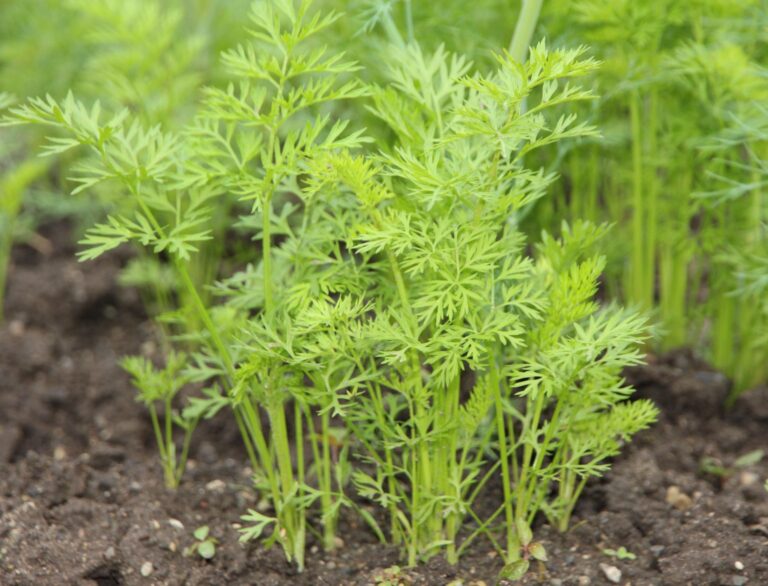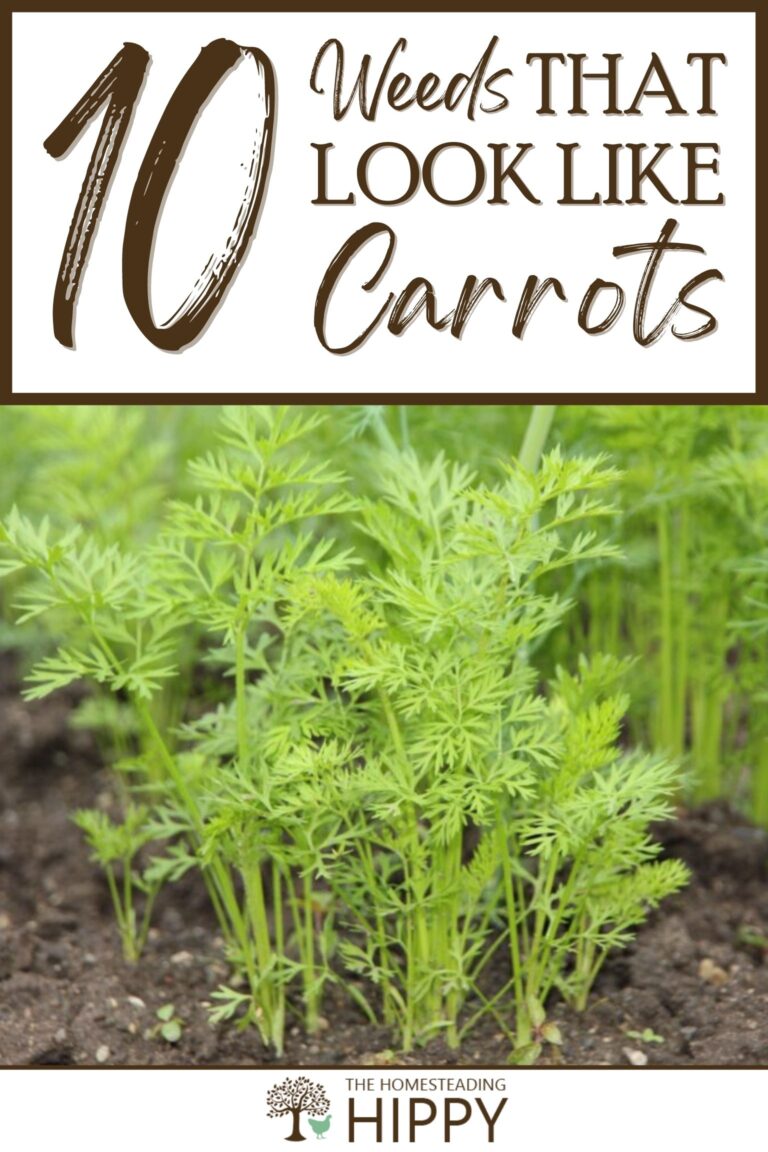I don’t know about you, but there’s hardly anything nicer than finally pulling up some perfectly formed, crisp, sweet carrots from my garden or raised beds.

But, if you aren’t taking good care of your garden, you might be in for a surprise… That’s because there are many weeds that look like carrots but aren’t!
In fact, when you reach for one of those really green tops you might be in for a nasty surprise, because several of these look-alikes are dangerously toxic!
Not all of them are, but regardless it is in your best interest to be able to recognize your carrots with certainty. Keep reading and I’ll tell you about 10 look-alike weeds that look like your carrots.
Table of Contents
Always Positively ID Any Plant You Consider Eating!
A quick note before we get to the list: whether you are harvesting carrots from your own garden or raised beds, or you are scrounging for wild carrots out in nature, it is absolutely imperative that you positively ID any plant that you think about eating!
That’s because several plants that look just like carrots, or carrot greens, are dangerously toxic and if you eat them that might be the last thing that you do. Even touching many of these plants is dangerous.
The devil is in the details, so do your homework and study the differences between carrots and any look-alikes that grow in your region.
1. Poison Hemlock (Toxic)
We might as well start this list with one of the worst look-alikes you could conceivably run into.
Everything you need to know about poison hemlock is in the name, and this infamously toxic plant has claimed many lives, human and animal, over the years.
This is a really tricky one to contend with if you grow, or are gathering, carrots because poison hemlock produces feathery, delicate and branching frond-like leaves that look very close to carrots.
The difference is, and the obvious giveaway, is that the stems have noticeable dark colored purplish splotches. Carrot stems are green without any spots.
Also be alert for a distinctly unpleasant odor emitted by the plant, especially if broken. Poison hemlock also produces crowns of small, white flowers that are loosely clustered, each bearing five petals which might be mistaken for the delicate, pale flowers of carrots.
If this plant matures, you probably won’t mistake it for carrots because it grows so much taller than they do; poison hemlock can clear 6 feet (1.8 meters) in height.
2. Water Hemlock (Toxic)
Water hemlock is similar to poison hemlock, and it’s nearly as deadly. Like poison hemlock, the leaves of water hemlock are delicate, divided thin fronds, and the stems of this plant are likewise often seen marked with purple or maroon colored blotches and streaks.
It’s dangerous to the touch, but if you can get a look at the roots safely: if you notice clusters of bulbous protrusions, you’ll know you’re not dealing with a carrot which is a single, long tap root.
As the name suggests, water hemlock is usually found near water sources, and it’s particularly common in perennially wet, marshy areas.
It should be noted that this plant is not safe to handle without protective gear; the toxins can be absorbed through the skin, though they’re particularly dangerous when ingested.
Mistaking this deadly look-alike for edible carrot greens or for Queen Anne’s Lace will probably be a fatal mistake.
And once again, water hemlock grows way taller than any carrot, though it usually has a similar nimbus of delicate, white flowers at the top.
3. Swinecress (Non-Toxic)
Another flowering weed, this time in the mustard family, swinecress is a spreading herbaceous plant that consists of many long, forking stems with deeply creased leaves that sprout small, white flowers.
When the plant is young, they bear a superficial resemblance to the tops of carrots and might be confused for them.
However, the leaves themselves and the stems look distinctly different upon close examination and swinecress tends to grow along the ground rather than vertically.
Also, pay attention to the fragrance: these smell mustardy and tangy unlike the green, earthy smell of carrots.
Unlike several other plans on this list, this one is not toxic and is indeed edible, although the flavor is so pungent many people are turned off by it.
4. Sweet Cicely (Non-Toxic)
Another herbaceous plant, this one actually cultivated for kitchen use routinely, sweet cicely grows between two and four pennant, feathery, fern-like leaves covered with a fine fuzz.
At the end of these stems grow clusters of tiny, off-white flowers. This is one that you might mistake for a carrot, and also for the drastically more dangerous hemlock plants above.
But sweet cicely is totally harmless, and it smells strongly of anise, or licorice, and is used in many recipes and also as an herb. It can be safely eaten cooked or raw.
5. Angelica (Somewhat Toxic)
Angelica is another perennial herb, or biennial herb depending on the species, that grows throughout the northern hemisphere.
Though it grows quite a bit taller than carrots, the bipinnate leaves on young stems might be mistaken for carrots if they’re growing nearby. This plant, like many others on our lists, produces large umbels of tiny white or mint-green flowers.
Although historically used in various traditional medicines, this is another plant you’ll need to be careful with: roots and rhizomes of all species contain compounds which can sensitize your skin to sunlight, potentially leading to significant sunburns if you are affected unknowingly.
If it is growing nearby, I recommend you get rid of it.
6. Cow Parsnip (Toxic)
A tall growing, herbaceous perennial that can sometimes clear 10 feet, this is another toxic plant on our list and yet another one that grows those dense, tiny clusters of white flowers near the top a thick, hollow stems.
But the really nasty feature of cow parsnip is the photosensitive toxins it contains: once you get the clear sap on your skin and it is exposed to UV light, which will happen almost immediately, it will result in a nasty rash and hyperpigmentation. The resulting blisters and subsequent scars can last for many months, or even years.
Nonetheless, it is possible to prepare and eat the plant safely, although I cannot recommend that anyone even attempt it. Getting this stuff in your mouth will make for a very, very bad time.
7. Giant Hogweed (Toxic)
With similar divided, compound leaves of the kind that you will see on most carrot tops, it is easy to confuse for our humble carrot although careful inspection reveal that the leaves of this giant hogweed are significantly bigger at the same age.
And as the name would suggest, giant hogweed grows extremely tall, upwards of 16 feet.
The stems of giant hogweed are stout, hollow and covered in coarse fuzz with dark blotches similar to hemlock.
Like that horrible plant, giant hogweed is extremely toxic only here the sap of the plant causes horrific burns after reacting with UV light.
This plant is easily confused with the next one on our list, Queen Anne’s Lace, and once you touch the stuff you’ve only got about 30 minutes to wash the sap off before exposure to sunlight or result in severe burning and blistering.
The sensitivity induced by the sap of the giant hogweed will persist for at least 2 days, so be careful!
8. Queen Anne’s Lace (Non-Toxic)
Finally, a look-alike that won’t kill us. In fact, Queen Anne’s Lace is also known as wild carrot, and for good reason: that’s really all it is!
Queen Anne’s lace has the same feathery crown of leaves that our garden carrots do, and even a single, orange tap root although it is rarely as vivid and bright as the carrots we are used to.
And as you might expect, the plant gets its name from the huge spray of small white flowers that bloom on it.
Although it is edible, and tasty, great care must be taken to avoid mixing up Queen Anne’s Lace with the other dangerous plants on this list.
Also be cautious if you try to cultivate it because it is highly invasive in many areas and grows and spreads quickly.
9. Annual Buttonweed (Non-Toxic)
Growing in the same environments that carrots typically grow in, and looking very much like carrots, annual buttonweed is nonetheless an entirely different plant and one that grows nowhere near as large as garden- or wild carrots.
Maxing out at only around 4 inches in height, this plant typically forms a carpet of foliage where it is thriving instead of growing upright.
When it does flower, it produces inflorescences that are tiny yellow discs, and subsequently a composite fruit, or achene, hardly a few millimeters wide.
Once your carrots mature, you probably won’t mix them up but it can be a problem when your carrots are first sprouting.
It is commonly encountered in wetlands and near other water features, so if you live in a moisture-prone area this plant will be more of a consideration.
Annual buttonweed is not toxic, but other similar Cotula genus plants are toxic to horses and other livestock if eaten, so take care if you have animals around and spot this one.
10. Common Ragweed (Non-Toxic, Highly Allergenic)
The bane of many an allergy sufferer’s existence, common ragweed leaves like carrot tops, are tightly divided, fine and frond-like, and they grow on either side of a stem in the middle, again just like carrots.
Common ragweed is not overtly toxic, but is extremely allergenic and its pollen persists for days in the air.
It’s an easy thing to confuse ragweed and carrots when the plants are young, but even here they can be distinguished: the central stem of a ragweed plant is significantly stiffer and more upright compared to the tops of a carrot which bend more readily downward.
Additionally, current leaves radiate out from a single point on the stem, while ragweed leaves alternate along the length.
And once again, your nose knows: carrot leaves smell like carrots when they are crushed or broken, whereas ragweed doesn’t really smell like anything.
Other Carrot Lookalikes to Know
There are many more carrot lookalikes you should know about depending on where you live and which plants are endemic to the area. Some other convincing carrot imposters are:
Yarrow
Low growing like carrots, but spreads wider. Toxic to mammals!
Fernleaf Biscuitroot
This fancifully-named plant grows in dry areas and is related to carrots. Edible, but might cause rashes in some people.
Wild Celery
Also known as Garden Angelica. Leaves look similar to carrots. Edible.
Wild Parsnip
Resembles carrot tops, but grows taller and flowers are distinctive. Toxic; sap causes blistering with exposure to sunlight!
Burweed
A scourge on lawns, this low-growing weed forms spiny seed pods that can puncture paws and bare feet. Also contains toxic glycosides, but unlikely to be eaten.
Pineapple Weed
Herb used in salads and for other purposes. Smells like pineapple when crushed. Grows taller than carrots, but easily mistaken when young.

Tom has built and remodeled homes, generated his own electricity, grown his own food and more, all in quest of remaining as independent of society as possible. Now he shares his experiences and hard-earned lessons with readers around the country.
Find out more about the team here.
